The Comprehensive CBD History Guide: Origin, Use and More
Written by: Hunter Podell, Subject Matter Expert and Website Founder
Published: March 15, 2024; Last updated: April 6, 2024
- 1. Key Takeaways
- 2. Ancient Roots: The Early Use of Cannabis
- 3. Pioneering Discoveries: Isolation of CBD and THC
- 4. Unraveling the Endocannabinoid System
- 5. Legal Challenges and Breakthroughs
- 6. Medical Milestones: Epidiolex and Beyond
- 7. The Rise of the CBD Market
- 8. Navigating the World of CBD Products
- 9. Ensuring Quality and Safety in the CBD Industry
- 10. Global Perspectives: CBD Regulations Around the World
- 11. Potential Future Developments in CBD Research and Medicine
- 12. Summary
- 13. Frequently Asked Questions
- 13.1 What is the history of CBD hemp?
- 13.2 How long has CBD been on the market?
- 13.3 What year did CBD become legal?
- 13.4 What was CBD originally used for?
- 13.5 What is the endocannabinoid system and how does CBD interact with it?
- 14. References
Ever wondered how CBD transitioned from an obscure ancient remedy to a major modern wellness product? This article cuts through CBD’s rich tapestry of history, exploring the fascinating CBD history from its therapeutic use thousands of years ago to the scientific discoveries and legal tides that shaped its current global status. Peek into CBD’s historical voyage and its impact on medicine, law, and culture, setting the foundation for the substance’s contemporary acclaim.
Key Takeaways
- Historical evidence shows that the therapeutic use of cannabis dates back over 12,000 years, with significant applications across ancient civilizations such as China, Egypt, Greece, and Rome, for a variety of ailments including arthritis and depression.
- Chemist Roger Adams isolated cannabidiol (CBD) and identified the structure of THC in the early 1940s, while Raphael Mechoulam furthered this research in the 1960s, leading to the discovery of the endocannabinoid system—a major breakthrough in understanding how cannabinoids interact with the human body.
- The legal status of CBD and cannabis has dramatically evolved from the Marihuana Tax Act of 1937 to the 2018 Farm Bill, which federally legalized hemp-derived CBD with less than 0.3% THC content, triggering significant industrial growth and scientific research into its therapeutic potential.
Ancient Roots: The Early Use of Cannabis

While many might not realize it, the history of CBD dates back thousands of years, with evidence first found near the Altai Mountains in Central Asia, where cannabis use was recorded around 12,000 years ago. It was here that mankind first discovered the therapeutic potential of cannabis, a discovery that would change the course of medicinal history.
Ancient societies, from the Chinese to the Egyptians, Greeks, and Romans, recognized the therapeutic applications of cannabis. ¹ For ailments as diverse as:
- arthritis
- depression
- inflammation
- asthma
Cannabis proved to be a panacea of sorts, a testament to its versatility. Hence, cannabis plants that initially symbolized survival and utility, soon became a harbinger of health and wellness, thanks in part to cannabis extracts.
Intriguingly, cultural and religious practices also embraced the cannabis plant. The Hindu ceremonies used it as ‘bhang’ to appease gods and provide medicinal benefits, with its fever-reducing property aligning with the modern understanding of THC’s effects.
From an ancient herb to a modern-day marvel, the cannabis plant has woven an intricate tapestry across the fabric of time. It has stood the test of time, persisting through the centuries, its therapeutic applications documented in ancient texts and revered in traditional medicine. However, the story of cannabis and, by extension, CBD, is far from over. This was just the beginning.
Pioneering Discoveries: Isolation of CBD and THC

Moving into the 20th century, a period marked by significant scientific advancements and innovative discoveries. It was during this time that chemist Roger Adams made a groundbreaking discovery—the isolation of cannabidiol, or CBD, in the early 1940s. Adams, with his path-breaking work, laid the foundation for future cannabinoid research, a feat that would have far-reaching implications.
Adams didn’t stop at isolating CBD. He went on to identify THC’s molecular structure and even received a patent for his method of isolating CBD in 1942, thereby etching his name in the annals of cannabinoid chemistry.
Building on Adams’ work, Raphael Mechoulam succeeded in isolating and elucidating the structures of CBD in 1963 and Δ9-THC in 1964, marking significant milestones in cannabinoid research. These discoveries were not mere endpoints; they opened up new avenues for further exploration.
Mechoulam synthesized various forms of THC and CBD in 1965 and further explored their effects, demonstrating THC’s psychoactivity and CBD’s therapeutic potential. The discoveries of Adams and Mechoulam set the stage for a deeper understanding of cannabis compounds and their effects, sparking a surge of interest in cannabis research.
Unraveling the Endocannabinoid System

Unveiling CBD and THC subsequently resulted in an equally notable discovery—the endocannabinoid system’s identification. This complex system, identified through cannabinoid pharmacology research, includes cannabinoid CB1 and CB2 receptors, along with endogenous ligands for these receptors, and plays a critical role in regulatory functions. ¹
Two known endocannabinoids within the system are anandamide and 2-arachidonoylglycerol (2-AG). The term ‘anandamide’ is derived from the Sanskrit ‘ānanda’, which means ‘bliss’, reflecting the historical connection of cannabis to human experiences with happiness.
The endocannabinoid system is unique. It features a unique retrograde signaling mechanism, where endocannabinoids like anandamide are produced post-synaptically and then travel back to interact with presynaptic cannabinoid receptors.
This system is implicated in various physiological processes, including:
- Affective and cognitive functions
- Stress response
- Endocrine regulation
- Energy balance by regulating food intake centers, gastrointestinal tract activity, and metabolic functions such as lipid synthesis and glucose metabolism.
A key player in this system is CBD. CBD, which does not produce intoxicating effects, interacts with the endocannabinoid system, showing promise for anti-inflammatory, antioxidant, and analgesic properties, among others. The unraveling of the endocannabinoid system underscored the vast therapeutic potential of CBD.
Legal Challenges and Breakthroughs
The saga of CBD encompasses:
- Historical usage
- Significant discoveries
- Intricate systems
- Legal hurdles and victories
The legal landscape of CBD has seen significant shifts over time, starting with the Marihuana Tax Act of 1937, which marked the beginning of federal cannabis regulation and set the stage for future discussions on legalizing cannabis. ¹
Introduced by Rep. Robert L. Doughton and influenced by Harry Anslinger, the Marihuana Tax Act:
- Placed a tax on all cannabis sales, including hemp
- Effectively restricted only taxed and approved hemp to be grown or sold
- Some attribute its enactment to efforts to diminish the competitive hemp industry.
Despite the Act, the Department of Agriculture and the US Army promoted hemp cultivation during World War II, owing to the material needs for the war effort. However, the Marihuana Tax Act was eventually declared unconstitutional and repealed by the Comprehensive Drug Abuse Prevention and Control Act of 1970, which included the Controlled Substances Act.
A significant legal breakthrough came with the 2018 Farm Bill, which:
- Removed hemp, defined as cannabis with less than 0.3% THC by dry weight, from the Controlled Substances Act
- Legalized hemp at a federal level
- Influenced the rise of the CBD industry.
However, despite the legal status of hemp-derived CBD, the FDA has not recognized CBD as GRAS, making it illegal to sell as a food, dietary supplement, or animal feed. The FDA has taken action against companies with unsubstantiated therapeutic claims. It is currently assessing whether to create additional regulatory pathways for hemp-derived products, including CBD, to ensure safety and efficacy under the FD&C Act.
Medical Milestones: Epidiolex and Beyond
Recognizing CBD’s medical achievements is fundamental to understanding its complete narrative. A significant landmark in this regard is the approval of Epidiolex by the FDA. Consisting of purified CBD, Epidiolex was the first medication of its kind to receive FDA approval for controlling seizures in two severe forms of epilepsy, representing a significant milestone for CBD as a viable treatment option.
The efficacy of Epidiolex was confirmed through multiple randomized, double-blind, placebo-controlled trials. These trials showed a significant reduction in the frequency of seizures in those treated with Epidiolex compared to placebo.
Initially approved for Lennox-Gastaut Syndrome and Dravet Syndrome, the label for Epidiolex was later expanded to include the treatment of seizures associated with tuberous sclerosis complex. This expansion highlighted its versatility in treating various seizure disorders.
However, like any medication, Epidiolex came with its share of side effects. Patients reported the following side effects ²:
- Sleepiness
- Decreased appetite
- Diarrhea
- Increased liver enzymes
- Lack of energy
- Rash
These adverse effects are considerations for medical professionals when prescribing this drug.
The approval of Epidiolex is a testament to CBD’s potential in the medical field. It signifies not just a breakthrough for CBD, but also a beacon of hope for patients grappling with severe forms of epilepsy. It underscores the potential of CBD as a viable treatment option, paving the way for further exploration of its therapeutic applications.
The Rise of the CBD Market

An exploration of CBD’s flourishing market is integral to its comprehensive journey. Here are some key statistics :
- Analysts predict that the CBD industry will be worth an astounding 22 billion dollars by 2022.
- The global cannabidiol market size was valued at USD 7.71 billion in 2023.
- It is expected to grow at a compound annual growth rate (CAGR) of 15.8% from 2024 to 2030.
The rise of the CBD market is driven by several factors, including:
- Legalization and interest in the potential health benefits of CBD
- Greater investment in research and new product development
- Businesses leverage technology and digital marketing strategies to establish brand recognition and outpace competitors.
Key companies in the CBD industry include:
- ENDOCA
- Cannoid, LLC
- Medical Marijuana, Inc.
- Folium Europe B.V.
- Canopy Growth Corporation
The rise of e-commerce has significantly boosted the CBD market growth, with companies reaching wider audiences and scaling up online sales.
Future growth of the CBD market may be shaped by factors such as regulatory changes, ongoing scientific research, and market saturation challenges. The rise of the CBD market is a testament to the increasing acceptance and popularity of CBD among consumers, further propelling its journey.
Navigating the World of CBD Products
The variety of CBD products expands in tandem with the growth of its market. Consumers are spoilt for choice, with options including:
- Oils
- Gummies
- Topicals
- Capsules
- Pills
- Vaping liquid
- Mist sprays
- Products for pets
CBD products come in three main categories:
- Full-spectrum, which contains all parts of the cannabis plant and trace THC
- Broad-spectrum, which includes most plant compounds and very minimal THC
- Isolates, which are purely CBD without other cannabinoids.
CBD oils, used sublingually, can come in various strengths and flavors. Topicals like creams and balms are applied to the skin for localized relief, while edibles such as gummies offer a flavorful and digestible CBD option.
The absorption of CBD varies among product types. Here is a breakdown of the different types and their onset of effects:
- Oils and tinctures: can take effect within 30 minutes
- Edibles: may peak within two hours but occasionally take longer
- Inhalation via vaporizers: offers a rapid onset of effects
- Topicals: the time for topicals to work can be variable
Navigating the world of CBD products can be overwhelming, given the wide array of options. However, understanding the different product categories and their properties can help consumers make informed choices that best suit their needs and preferences.
Ensuring Quality and Safety in the CBD Industry
In the face of burgeoning CBD products, the assurance of quality and safety takes precedence. High-quality CBD products should:
- Be independently tested
- Be accompanied by a Certificate of Analysis (COA)
- Verify the product’s content and purity, including levels of CBD, THC, and the absence of harmful contaminants like pesticides, microbes, and heavy metals.
Consumers should choose CBD products from reputable companies that provide transparent third-party lab results and are cautious about added chemicals or unconfirmed health benefit claims.
The FDA plays a significant role in the regulation of CBD products. It:
- Issues warnings to companies with unverified claims
- Explores lawful pathways for marketing
- Conducts studies revealing inconsistencies in product labeling and content.
Ensuring quality and safety in the CBD industry is a multifaceted endeavor. It requires the collective efforts of manufacturers, regulatory bodies, and consumers.
By choosing products with transparent third-party lab results, consumers can ensure they’re getting safe, high-quality CBD. Meanwhile, regulatory bodies like the FDA continue to monitor and regulate the industry, working towards a safer, more reliable CBD market.
Global Perspectives: CBD Regulations Around the World
Regulations surrounding CBD extend beyond national parameters—they are a matter of global interest. Around the world, countries have adopted different approaches to the legal status, cultivation, and sale of CBD. This reflects diverse perspectives on CBD’s potential benefits and risks.
In Canada, CBD falls under the same regulations as cannabis per the Cannabis Act. It’s classified as a controlled substance, and a federal license is required for its cultivation. This contrasts with countries like Switzerland, where CBD is not subject to the Swiss Narcotic Acts due to the absence of psychoactive effects.
Other countries, like New Zealand, have shifted from tighter controls to more relaxed regulations regarding medical cannabis, addressing the issue of substance abuse. CBD is no longer considered a controlled drug there; under the Misuse of Drugs (Medicinal Cannabis) Amendment Act, it is now a prescription medicine.
On the other hand, Hong Kong has completely prohibited cannabidiol, illustrating the spectrum of regulatory approaches from permissive to outright bans. Even within the same continent, regulations can vary. For instance, Sweden’s Supreme Court has classified CBD oil with any THC as a narcotic, while the European Commission concluded CBD should not be considered a drug and can be classified as food.
These global perspectives on CBD regulations underscore the complexity and diversity of the legal landscape surrounding CBD. They highlight the need for international dialogue and cooperation in establishing a globally accepted regulatory framework.
Potential Future Developments in CBD Research and Medicine

At this juncture in CBD’s evolution, we anticipate future advancements in CBD research and therapeutics. Some potential areas of exploration include:
- Investigating its therapeutic applications for various conditions
- Understanding its long-term effects on the body
- Advancing delivery methods to improve absorption and bioavailability
The future of CBD looks promising, with the potential for new discoveries and innovations in the field.
Researchers are exploring CBD’s potential therapeutic applications for conditions such as obesity, diabetes, neurodegeneration, inflammatory diseases, gastrointestinal and skin issues, pain, and cancer. Additional clinical trials and preclinical studies are evaluating CBD as an adjunctive therapy for schizophrenia, anxiety reduction, neuropathic pain management, and psychotic disorders.
Advancements are also being made in CBD delivery methods. Innovations such as nanoemulsions, liposomes, and transdermal patches aim to improve bioavailability and ensure consistent dosing. There’s also ongoing research into the entourage effect, which suggests the therapeutic effects of CBD could be enhanced when used in combination with other cannabinoids and plant compounds.
However, future developments in CBD research and medicine also come with challenges. Understanding its long-term effects on chronic pain, especially on vulnerable populations such as children, pregnant women, and the elderly, as well as its potential liver toxicity and drug interactions, requires extensive clinical trials and observational studies.
Addressing current regulatory barriers, including the Schedule I status of cannabis, is crucial for advancing comprehensive research and medical access to cannabinoid-based medications. The future of CBD research and medicine holds much promise, but it requires overcoming these regulatory and logistical challenges to fully unlock CBD’s potential.
Summary
As we conclude our journey, we reflect on the remarkable story of CBD. From its ancient roots to its modern-day significance, CBD has been a constant companion in our quest for health and wellness. The journey of CBD is a testament to human curiosity, scientific exploration, and our enduring pursuit of understanding the world around us and within us. As we look towards the future, we continue to explore the therapeutic potential of CBD, driven by the hope of unlocking new pathways to health and wellness.
Frequently Asked Questions
What is the history of CBD hemp?
CBD hemp has a rich history dating back to 2737 BCE in ancient Chinese medical texts, where it was used as a natural remedy for various conditions. Its cultivation began around 10,000-12,000 years ago, likely for textile fiber, and its usage in medicine was documented by Chinese Emperor Sheng Nung in 2737 BC.
How long has CBD been on the market?
CBD has been on the market since the late 1930s when it made its first appearance after the Marihuana Tax Act of 1937.
What year did CBD become legal?
CBD became legal in 2018 due to the Agriculture Improvement Act, which removed hemp from the federal Controlled Substances List. This effectively legalized CBD if it comes from hemp.
What was CBD originally used for?
CBD was originally used for treating gout, malaria, and rheumatism, with the first recorded use dating back to 2737 B.C. in China.
What is the endocannabinoid system and how does CBD interact with it?
CBD interacts with the endocannabinoid system through cannabinoid CB1 and CB2 receptors, showing promise for various properties such as anti-inflammatory and antioxidant effects.
References
Bridgeman, M. B., & Abazia, D. T. (2017). Medicinal Cannabis: History, Pharmacology, And Implications for the Acute Care Setting. P & T : a peer-reviewed journal for formulary management, 42(3), 180–188.
https://www.ncbi.nlm.nih.gov/pmc/articles/PMC5312634/
Wikimedia Foundation. (2024, February 17). Cannabidiol. Wikipedia. https://en.wikipedia.org/wiki/Cannabidiol

Written by Hunter Podell - Subject Matter Expert and Website Founder
Hunter has 8+ years of experience as a content writer and digital marketer. Earning his chops marketing in the healthcare space for over 5 years, Hunter is extremely familiar with the rules and regulations required to deliver high quality content that answers the user's needs while adhering to strict guidelines.
Join the CBDeals Club!
Get 10% off your first order and receive our best and exclusive promotions directly to your inbox!



